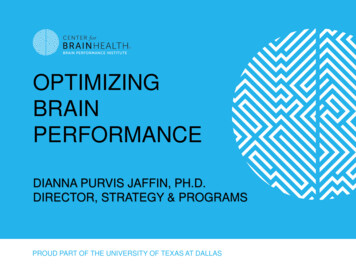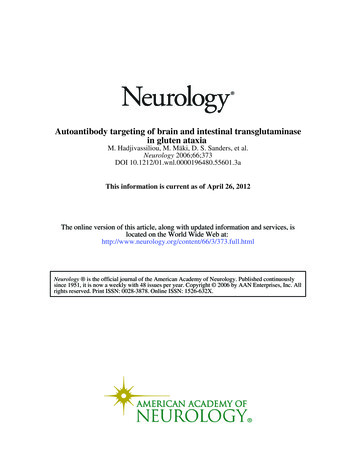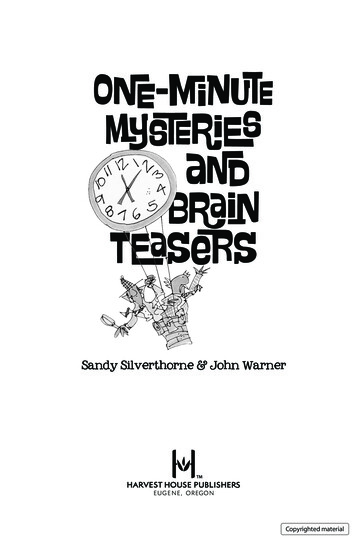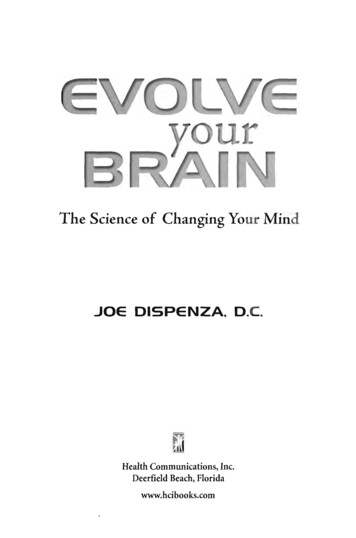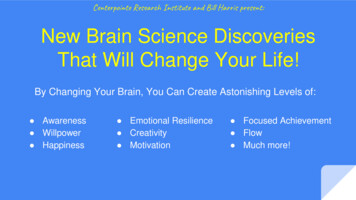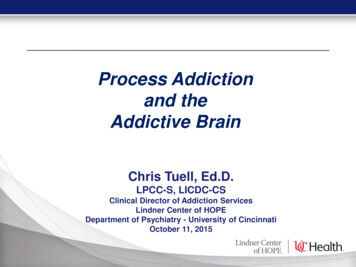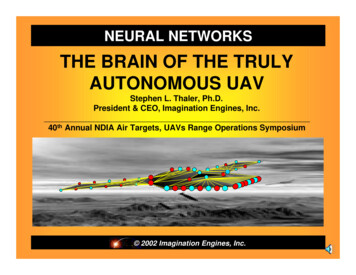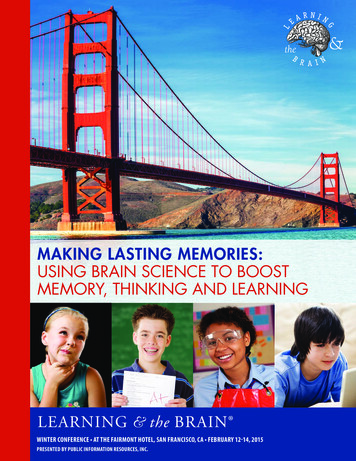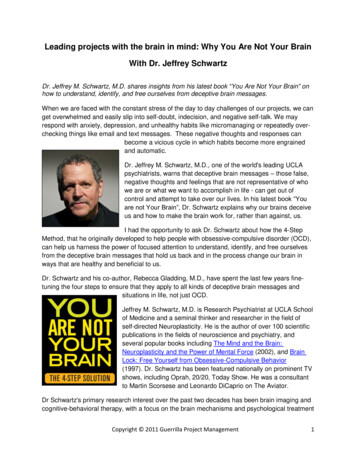
Transcription
Leading projects with the brain in mind: Why You Are Not Your BrainWith Dr. Jeffrey SchwartzDr. Jeffrey M. Schwartz, M.D. shares insights from his latest book “You Are Not Your Brain” onhow to understand, identify, and free ourselves from deceptive brain messages.When we are faced with the constant stress of the day to day challenges of our projects, we canget overwhelmed and easily slip into self-doubt, indecision, and negative self-talk. We mayrespond with anxiety, depression, and unhealthy habits like micromanaging or repeatedly overchecking things like email and text messages. These negative thoughts and responses canbecome a vicious cycle in which habits become more engrainedand automatic.Dr. Jeffrey M. Schwartz, M.D., one of the world's leading UCLApsychiatrists, warns that deceptive brain messages – those false,negative thoughts and feelings that are not representative of whowe are or what we want to accomplish in life - can get out ofcontrol and attempt to take over our lives. In his latest book “Youare not Your Brain”, Dr. Schwartz explains why our brains deceiveus and how to make the brain work for, rather than against, us.I had the opportunity to ask Dr. Schwartz about how the 4-StepMethod, that he originally developed to help people with obsessive-compulsive disorder (OCD),can help us harness the power of focused attention to understand, identify, and free ourselvesfrom the deceptive brain messages that hold us back and in the process change our brain inways that are healthy and beneficial to us.Dr. Schwartz and his co-author, Rebecca Gladding, M.D., have spent the last few years finetuning the four steps to ensure that they apply to all kinds of deceptive brain messages andsituations in life, not just OCD.Jeffrey M. Schwartz, M.D. is Research Psychiatrist at UCLA Schoolof Medicine and a seminal thinker and researcher in the field ofself-directed Neuroplasticity. He is the author of over 100 scientificpublications in the fields of neuroscience and psychiatry, andseveral popular books including The Mind and the Brain:Neuroplasticity and the Power of Mental Force (2002), and BrainLock: Free Yourself from Obsessive-Compulsive Behavior(1997). Dr. Schwartz has been featured nationally on prominent TVshows, including Oprah, 20/20, Today Show. He was a consultantto Martin Scorsese and Leonardo DiCaprio on The Aviator.Dr Schwartz's primary research interest over the past two decades has been brain imaging andcognitive-behavioral therapy, with a focus on the brain mechanisms and psychological treatmentCopyright 2011 Guerrilla Project Management1
of obsessive-compulsive disorder (OCD).The interview:Samad: Mr. Schwartz, before we delve into your book, You Are Not Your Brain, I would like toknow how your landmark work in self-directed neuroplasticity and breakthroughs in obsessivecompulsive disorder research influenced the ideas that you share in this book.Dr. Schwartz: Oh, well, it influenced it a huge amount. This new book, You Are Not Your Brainis really just a broadening of the application of the earlier works, so there’s a completecontinuity. Basically, the work on obsessive-compulsive disorder came out of the fact that in themid-seventies, all through the eighties, actually all through the nineties, and into currentdecades, I was a very, very serious practitioner of the ancient, what I like to call pre-Christianform of Buddhist meditation in the Theravāda school. That is sometimes called the SouthernSchool of Buddhism. I was a very, very serious practitioner of that for thirty years, starting in1975. And, actually, in the Burmese tradition, and specifically a great Burmese meditationmaster by the name of Mahatma Simadha. Really, seriously practicing that for about ten yearsbefore we started doing the obsessive-compulsive research. I started doing that when I was amedical student and did it all the way through my psychiatry training. The whole notion of usingwhat now has actually become a very well-known term: mindful awareness. It’s actuallypractically merged into being pop-psychology in the last five to ten years, but back then, itwasn’t. It was a very serious notion of essentially – to put it in very lay-terms – a third-personperspective, or an outside perspective on your first-person inner experience. So, you learn howto have very, very acute, calm, clear-minded self-observation and skill.So I had been practicing that very, very seriously, and did for a long, long time. In the lastcouple of years, actually, I’ve kind of integrated it into in, and then become a serious Christianmeditator and it’s a whole other subject matter. They’re not that different, they’re actually infairly close relationship in numbers of ways. In fact, I’ve written about that on the internetbetween this ancient Buddhist meditation and especially Christian Jesus prayer meditation. Butthat said, when we started doing this obsessive-compulsive disorder research, which was reallyin sort of the late eighties it was really getting off the ground. I mean we started in the mideighties studying depression, doing brain imaging at UCLA. I’ve spent 25 years here at UCLAand this work actually started when I was still a trainee, before I became on the faculty. So, Ibecame really, really interested in this notion that mindful awareness or this capacity to observeyour inner experience could number one: treat psychiatric illness, and number two: it actuallychanged how your brain works. And these were the very early days of brain imaging in humansand to a significant degree, it started here in UCLA and a handful of other places. We, prettyearly on, were studying depression and then we thought well, obsessive-compulsive disorderseems like an interesting thing. And, we started to do that. Initially we had this very clear-cutfinding that has held up over time that people who have obsessive-compulsive disorder havenow a quite well described circuit in the brain, which is causing problems, and it’s centered onthe habit part of the brain.This is all explained in my first book: Brain Lock and it’s explained in more scientific detail in mybook: The Mind and The Brain, especially in chapter two, it’s called “Brain Lock” which is thesame title as the first book, which is really a self-help book. The point is that once we had thiskey finding of understanding this circuit. Which is really a circuit that runs from a part of theemotional frontal brain the limbic frontal cortex, an area specifically called the orbital frontalcortex, which sits right over the eye sockets and connects into the habit center of the brain.This is part of what’s called the basal ganglia, specifically part of the basal ganglia called theCopyright 2011 Guerrilla Project Management2
caudate nucleus. Basically, it’s an emotional frontal cortex into the habit center of the brain, andbasically, there is a brain lock in that circuit in people who have obsessive-compulsive disorder.They get this intrusive, bothersome urge to check things and wash things. At that time, as, upuntil today, medication, it was really the beginning of using medication to treat that in asystematic way, but there were also psychological treatments. I really wanted to integrate thismindful awareness into those psychological treatments. That’s what we did. We basicallyshowed that. I devised these four steps, which are still basically the four steps that are in thenew book, You Are Not Your Brain. We made small modifications to make it more generallyapplicable, but the key point which really does come out of this meditation tradition, is relabeling or putting an accurate linguistic label on how you’re feeling. That has now been shownin a lot of research to calm other emotional areas of the brain, specifically the amygdala, whichis really the emotional fear/anxiety center of the brain to a very significant degree.The summary really becomes that this use of mindful awareness, before a lot of this researchhad ever, ever been done on mindful awareness, much less my use of brain imaging to studymindful awareness, in the last ten years there’s been quite a bit of that, so this is many yearsbefore that. We were fortunate in the very early nineties, we did this research in the lateeighties and early nineties, and in 1992 we published a paper which really showed that this formof psychological therapy that I had used, this mindful awareness to amplify the effects of this.Not only was this effective in treating people who had obsessive-compulsive disorder, but itreally did change the brain activity. Normalized, as it were, the brain activity in this circuit, thisbasically obsessive-compulsive disorder circuit in the brain that runs from the orbital frontalcortex to the caudate nucleus. Basically causing the habit center in the brain to lock. The lockis for genetic reasons. It turns out that obsessive-compulsive disorder has very significantgenetic neurological aspects to it. Yes, you can treat that with medication, but we also areshowing that just using psychological therapy enhanced by mindful awareness, you can treat itand get changes in brain activity that correlated with the functional improvement that peoplehave. So that salvational finding has been, and the fact that we use these four steps, re-label,then we called it reattribute, now we call it refrain, refocus which is the key step that actuallychanges how the brain works and revalue and I’m sure we’ll have a chance to go over that inmore detail. So those steps really came up in that research, and the fact that it affects how thebrain works was substantiated in the early and mid-nineties. We then went out and repeatedthe whole study again with a whole new set of subjects. By the mid-nineties when Brain Lockwas published, all this research had basically been done to show that mindful awareness anddirected attention especially could change how the brain works and that there are four steps thatpeople can readily learn to manage their emotional responses to these deceptive brainmessages.Samad: Dr. Schwartz, you say in the book, “Nothing is more confusing or painful than when thebrain takes over your thoughts, attacks your self-worth, questions your abilities, overpowers youwith cravings or attempts to dictates your actions.” You attribute this to the deceptive brainmessages and thinking errors. Talk to us a little bit more about deceptive brain messages andhow they impact our lives.Dr. Schwartz: You know there are two broad classes of deceptive brain messages. If you’redealing with something like obsessive-compulsive disorder, to a significant degree, as I justsaid, there’s a neurological component that’s genetically inherited, actually has to do with faultywiring in the habit center. And so the deceptive brain messages are really being generated bythe brain really for reasons that have a lot to do with just a neurological malfunction that isgenetically inherited. Even in those cases, you can actually change that with just trainedattention by understanding what it is, not giving in to it, and focusing your attention differently.Copyright 2011 Guerrilla Project Management3
For most people, the vast majority of people, because obsessive-compulsive disorder effectsabout two percent of people, the vast majority of people have deceptive brain messages thatare not caused, anything like the same degree, nor do they have quite the same intensity as aneurological cause. So you can, because the focus of attention and the way people respond towhat they believe really does wire the brain, then deceptive brain messages in most cases ariseby basically faulty learning that has occurred earlier in life. So, you learn things about how youinterface with the world. Your sense of self-worth, your sense of self-criticism, your sense ofbeing accepted by others; lots of cognitive distortions as to how we understand what’shappening to us and how we manage anxiety. Many of these things really just come in aslearned responses that occurred before we really realized what was happening. They are reallypsychological, have a psychological basis to a very, very large degree, and yet that too causesdeceptive brain messages and the reason why is just because focus of attention and repeatedbehavioral responses really, really does change how the brain is wired or what wires the brain toa very, very significant degree. That can be for good, or it can be for malfunction. When youlearn how to use mindful awareness for one thing, to assess how you’re responding and to havethis what we call wise advocate perspective on your emotions and how you’re responding tothem. Then you can focus your attention very, very constructively, and you can really overridedeceptive brain messages. Prior behaviors have been done before you learn how to use thewise advocate as constructively. Lots of things get wired in that are not maximal, so it reallydoes show the power of focused attention and behavioral response to wire the brain, and so alot of deceptive brain messages have all the results of prior learning that was not maximal.Fortunately, it can be changed and that’s the whole notion of neuroplasticity and especially selfdirected neuroplasticity, a term that I coined to mean that when you make choices about howyou respond you can actually wire the brain in ways that are self-directing.Samad: And that is just absolutely amazing that we now have that understanding, because for along time people just thought that once you have a habit or you’re born with a habit, or you’reborn with a characteristic or something like that, that you just live with it. But, this is such agreat hope.Dr. Schwartz: Well, it goes beyond that, I mean there is that. But, I’m thinking in general peoplemore or less know that yes, it is hard work, but all habits can more or less be changed. In ourcurrent era what really has happened is, one of the reasons that we call the book You Are NotYour Brain is because the opposite message has been drilled into people in our current era.There’s a certain philosophy of neuroscience which I think has become, unfortunately, toopredominant, which basically says you are your brain. Once they start doing the brain imagingexperiments and they see the brain respond in various ways to various circumstances, now Ithink there is a very significant sort of built up cultural belief that if your brain is doing it, there’sjust not a whole lot you can do about it. I mean, that’s – I really have a difference in perspectiveon that. That’s where the real change is. Yeah, your brain can be doing it, but that doesn’tmean that you’re destined to do it forever with no capacity to do anything about it. In this world,biology is absolutely not destiny. The choices that you make not only effect to a very significantdegree how your brain works, it also very significantly – and there’s a lot of work in a new fieldcalled epigenetics – which has become – it has become increasingly recognized as being ofvery great importance. The choices you make about behavioral responses and how youunderstand your environment absolutely have very significant effects even about your genome,how your genetic heritage gets expressed. Then it looks like even that becomes inherited itself.This issue of biological determinism is a message that still has significant culturalpredominance, but doesn’t deserve it. I think we should be even more so into a transitionalperiod away from this notion of material biological determinism. Materialism is incorrect inclaiming that because your material brain or your material genome is coded in certain ways, thatCopyright 2011 Guerrilla Project Management4
that forms your future destiny. That is not true. It does take the effort of focused attention andbehavioral change to rewire it and to change the coding. But, it is very important to get themessage out that through focused attention and through changes in behavioral response thatyou can record it. That’s where I think the major change in perspective needs to occur and isoccurring.Samad: Dr. Schwartz, let’s go back to another topic that you discuss a lot in the book, you saythe deceptive brain messages manifest themselves in the form of uncomfortable physical oremotional sensations and throughout the book you make sure to differentiate between trueemotions versus the emotional sensations. Talk to us a little bit more about the differencebetween these two concepts.Dr. Schwartz: Yeah, that’s a very deep concept and it is a very core part of the book, noquestion. Okay, so, and this really does have significant continuity with everything that’salready said before. The classic example of an emotional sensation would in fact be somethinglike obsessive-compulsive disorder. Here we have people who because of really a geneticallyinherited biological essentially wiring problem. This intrusive sensation that something is wrong,something is dirty, this needs to be checked, I have to do this again. This deep, visceralrepetitive intrusive feeling or sensation that has a very strong emotional content to it telling youto do things that really know don’t make a whole lot of sense and are absolutely not in your bestinterests. But, they are so strong that they are very, very hard to resist. That is an archetypalparadigmatic example of an emotional sensation caused by the brain. Now, a true emotion is avery, very different thing. Because a true emotion is truly related to your sense of self, andthere’s a whole lot in the book, You Are Not Your Brain, about how do you connect with yourtrue sense of self, your true self. This is where this concept of the wise advocate is soimportant, is the central core therapeutic aspect of the book. Because we all have within us awise advocate. This wise advocate is very intimately related to what I’ve been speaking about,mindful awareness. For those who are of the Christian faith, it’s very, very closely related to theHoly Spirit that all Christians believe we have within us, and it’s also related to the Holy Spirit inthe Jewish sense of the word, which is a Godly spirit that we can interface with. This notion of awise advocate is a major part of at least three major religions/traditions that happen to be thethree religious traditions that I by far know the most about. And I also know enough aboutHinduism that as well, and I would be almost certain that there is some aspect of it that’s inIslam as well. So I think this notion of a wise advocate is common to all the great religions inone way or another. This wise advocate that we all have, that all human beings have, which isin fact what makes us uniquely human, we through the connection to that can find a path to ourtrue self. We define our true self in terms of our connection with our wise advocate within us.Therein lies the very, very important difference between an emotional sensation, which is reallyjust a mechanical result of a neuronal process, it’s machine-like, especially when itmalfunctions, causes sensations, but then, with the wise advocate we all have the capacity tomake interpretations about those sensations. We do not need to be mechanical slaves to thesensations that our material nervous system creates. That is our animal nature. Our animalnature to a very significant degree can be understood as our material selves interacting with thematerial world. Yes, the sensations can be very intense, can be profound and obviously there’sa large instinctual component in it. We all have hunger, we all have thirst, we all have sexualdrives, I mean obviously a lot of these things have to do with core survival aspects of the animalaspects of ourselves. We don’t have to be reduced to that. We don’t have to be reduced tomaterial beings who don’t act different in principle from any other animal. Human beings havethe capacity not to respond to those emotional sensations in un-interpreted ways or in reflexiveways. Human beings do not need to be reflexive in their behavioral response the way thatanimals generally are.Copyright 2011 Guerrilla Project Management5
The difference is, and what we mean by true emotion is through the guidance of our inner wiseadvocate we look for the true emotional responses that connect us to our true selves. That iswhere we want our focus of attention to be. That is that awareness that we want to havedirecting our focus of attention, because the focus of attention – and I’ve done a lot of work overthe last fifteen years almost now with the very eminent quantum physicist Henry Stapp atUniversity of California Berkeley. We’ve co-authored a major paper in the “PhilosophicalTransactions of the Royal Society” in 2005, along with a third author, my very esteemedcolleague Mario Beauregard, a very great brain-imaging researcher at the University ofMontreal. So there is now a deep scientific theory which has been elaborated a number ofplaces, also very much in the mind and the brain which is elaborated in a much more userfriendly way in the new book You Are Not Your Brain, that says the focus of attention actuallyphysically changes how the brain works and we want that focus of attention to be directed byour wise advocate that we are using to connect to our true emotions, leading us on the path torealizing our true selves and our true self goals and our real self-worth and our connection witha community of people. Of course, that community of people can ideally come to encompass allpeople and even all living things including the Earth, etc., I mean on a level it’s become atranscendent virtual experience. That’s the path that we’re talking about with true emotion,mediated through awareness that is directed by our wise advocate and you can see howdifferent a thing that is than the mechanical emotional sensations which is really just our animalnature expressing itself in a material way. It’s the capacity for us to discern the differencesbetween those two and understand how our emotional sensations may be impeding or getting inthe way, obstructing our capacity to achieve our higher self, our true self that really leads to thechanges in focused attention that rewire the brain in the most constructive ways.Samad: Let’s now talk about the four-step method for overcoming our deceptive brainmessages and thinking errors.Dr. Schwartz: It’s a very user-friendly four-step approach that has been refined and refined andrefined for over twenty years now, and now has been in the new book, You Are Not Your Brain,designed to be applicable for all people. Certainly no longer for psychiatric issues primarily. It’sreally now for managing day-to-day stress and how to not be overcome by the anxieties that weall feel as part of just normal responses to the stresses of everyday life. The first one I’vementioned: re-label. That turns out to be very, very important, because putting an accuratelabel on what is happening turns out to be a core way of activating the mindful responses, thewise advocate understandings. It turns out that acknowledging that we’re anxious oracknowledging that we’re feeling stress is helpful. When we have ways of knowing how tomanage that stress it gives us a signal that tells us now we have to pay more attention to howwe’re responding, because when anxiety and stress are basically denied or are not dealt withawareness, they tend to control us much, much more. Also, fears as well, so just puttingaccurate labels on what’s going on, is very, very helpful. It puts us in a position where we’represent-centered. We're in the here and now. Simple example: Person comes into work, theystart checking their email, they get a call, there’s something else they have to attend to. Manypeople will feel, kind of talking from personal experience here, and I’m sure that many peoplehave had this, will feel like “Oh, I have to attend to this email; I can’t do the next thing unless Ido that.” If that’s become the habit, and if that’s become the distraction, it can really diminishyour productivity. Then you’re at a point where you can actually make a very – a day-to-daychoice – you re-label. You can say, “I’m being drawn to this email by a force of habit. I have toomuch attachment to getting a sense of completion about doing my email before I do anythingelse. Let’s go on to the next thing.” The way you go on to the next thing is by reframing thesituation. That’s the second step.Copyright 2011 Guerrilla Project Management6
Re-label means put an accurate label, reframe means understand why this deceptive brainmessage is bothering you, what it is and why it’s bothering you. Because now you’re realizing,“Wait, I have an excessive attachment to say, checking my email, this is due to a deceptivebrain message. This is due to the fact that I have repetitively spent so much time doing email,that doing email has become an automatic way that my brain responds to my early morningwork situation.” It’s become too mechanical. Now, habits can be extremely good, and can beextremely useful. But, the whole notion of using the wise advocate and the whole notion ofrelabeling is to be able to begin to tell when they’re not being functional. So that you don’t justdo them mechanically. So when you reframe, you say, “This is a deceptive brain message.”And then frequently these deceptive brain messages are tied into cognitive distortions. So,there are two parts to the reframe step. One has to do with understanding that the feeling itselfis caused by a deceptive brain message and that secondly that deceptive brain message islinked to a cognitive error, a cognitive error of thinking. Often, those cognitive errors are relatedto things like all-or-none thinking or negative prediction or fortune telling that prediction thatthings will not go well. So we get into patterns of thinking that basically lead us to think that “If Idon’t do it this way, it won’t work.” Or, this kind of pattern of cognitive distortions that lead ustoward thinking that if we don’t do things mechanically we’re going to fail or that why try to dothings differently because it’s not going to work. Cognitive distortions really do tend to lock inpatterns that are not maximal.Reframing allows us to see that deceptive brain messages are causing us to not trulyunderstand the cognitive truth about what’s going on in the situation right now. In the book welay out a whole set of cognitive distortions. My friend, and longtime colleague David Burns, alsohas done this work in terms of how to treat depression, and it’s become part of what’s calledCognitive Therapy, which is a very scientifically validated way of doing psychologicaltreatments. So, we see these cognitive distortions, we correct them, and there are charts andtables in the book that help you find your cognitive distortion. Once you put these two stepstogether, put an accurate label, reframe so that you see the deceptive brain message, see thecognitive distortions that are basically leading these deceptive brain messages basically tobecome a perpetual way of thinking that is not true, correct the cognitive error and then the keynext step is refocus. That’s the one that’s really, really important, that I was just elaborating onpreviously, where it can go all the way up to higher spiritual levels. It doesn’t need to be there,that’s for sure, it can be at a very mundane level, just focus on the next thing you need to dothat is going to be helpful to you. Don’t allow these feelings, don’t allow these emotionalsensations, don’t allow these deceptive brain messages, and don’t allow these cognitivedistortions to cause your responses to be less than maximal. Use your wise advocate, seewhere your true self is, and see where your true interests are. Focus on that and do somethingthat is going in that direction. That is what rewires the entire brain. Focus of attention is whatreally wires the brain and the underlying physics principle of that is related to what’s called thequantum zeno effect. This is explained in a very user-friendly way in You Are Not Your Brain,and in some more scientific detail both in The Mind and The Brain and then also of course in the“Philosophical Transactions of the Royal Society” paper. So, this notion that focused attentionstabilizes brain circuitry is really a well worked through aspect of standard orthodox aspects ofquantum physics. The refocus step is very, very important because that’s where you changethe brain. That’s why you want to refocus on things that are adaptive because then you wireyour brain in ways that are adaptive. When you do that regularly, your brain starts to change,everything starts to become revalued, and that’s the fourth step. As the brain starts to change,you come to revalue your responses to environmental stimuli and no longer have nearly asstrong an urge to respond in habitual ways or respond to deceptive brain messages in the wayyou used to. You put a different value on those emotional sensations; you don’t basically getCopyright 2011 Guerrilla Project Management7
deceived by them anymore. The deceptive brain messages are no longer deceptive to you, yousee them for what they are, you put a different value on them, and then you much moreautomatically focus your attention more productively. In other words, your wise advocate andyour true self and the focused attention that follows from them have rewired your brain to makeit much easier to recognize very quickly what deceptive brain messages are, see that they aredeceptive, put a different value on them, essentially they’re worthless, you don’t want to gothere, and the new brain circuitry that you’ve been wiring in through repeated refocusing startsto much more easily take over and you have a much more productive evaluation of your innerexperience and your inner responses to your environment and to stress. So those are the foursteps: re-label, reframe, refocus, revalue.Samad: Dr. Schwartz, do you have any final tips for using the four-step method to overcome ourdaily challenges?Jeffery Schwartz: There are relax
Dr. Jeffrey M. Schwartz, . Brain Lock and it’s explained in more scientific detail in my book: The Mind and The Brain, especially in chapter two, it’s called “Brain Lock” which is the same title as the first book, which is re

